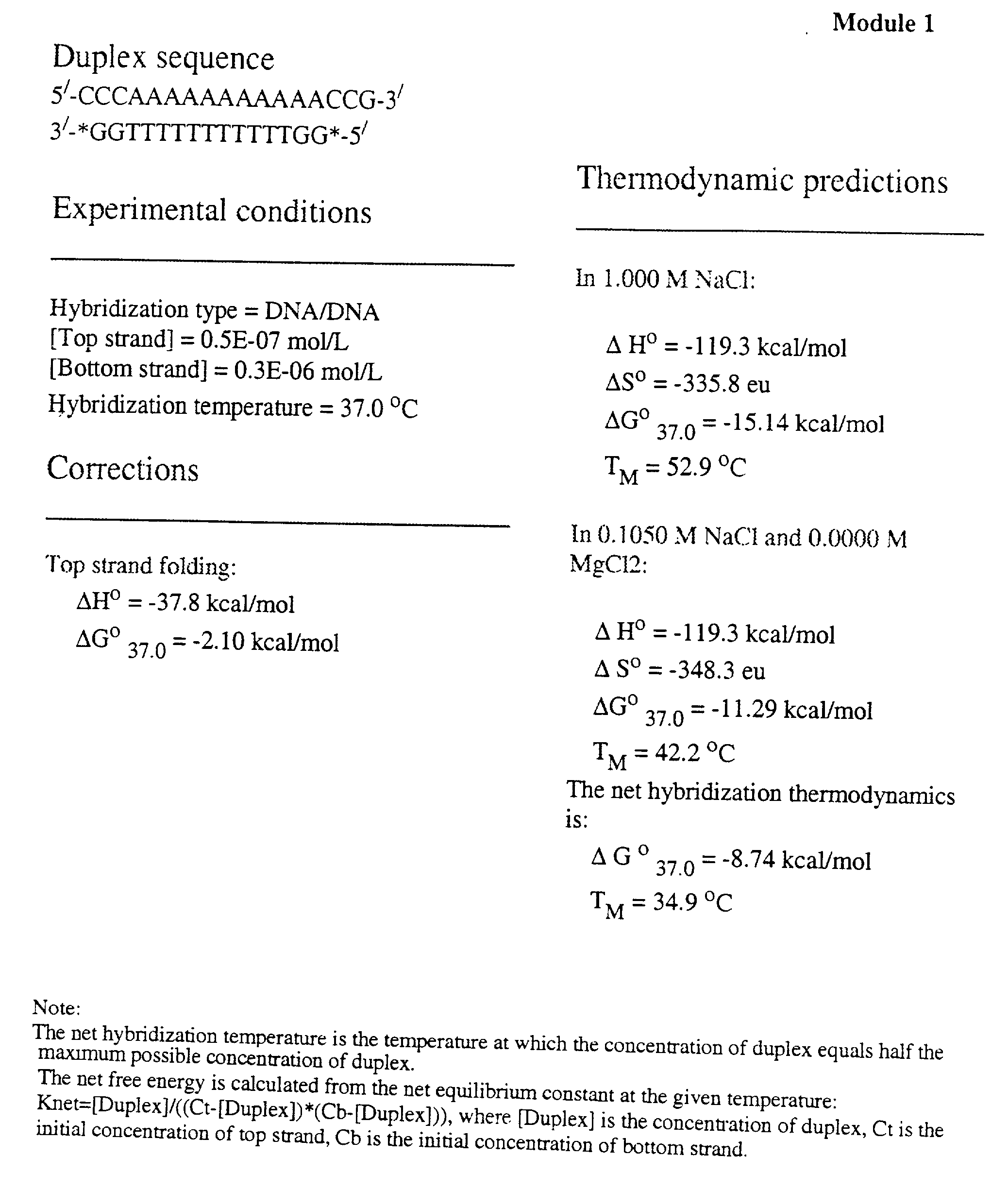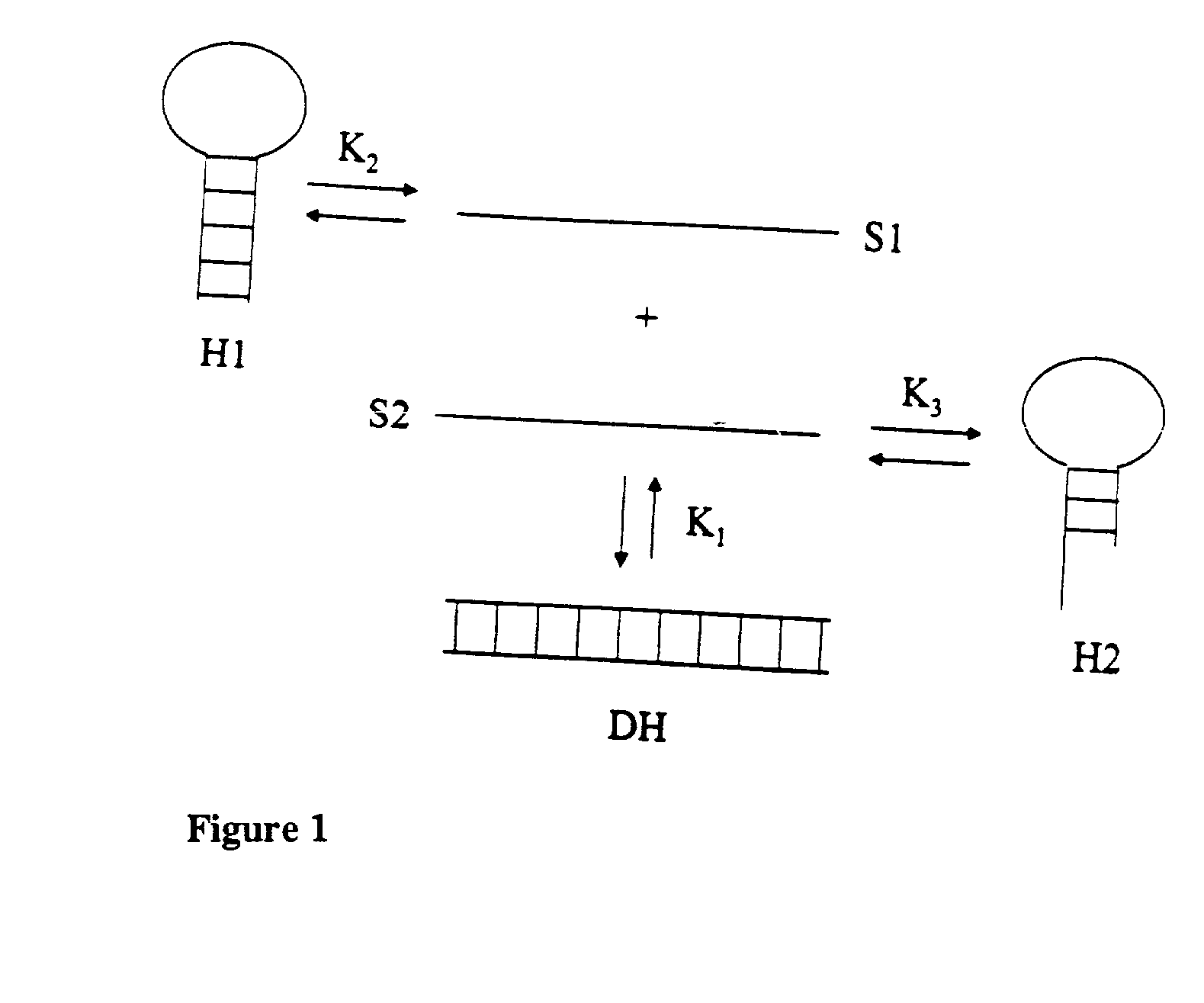Method and system for predicting nucleic acid hybridization thermodynamics and computer-readable storage medium for use therein
Inactive Publication Date: 2003-12-04
WAYNE STATE UNIV
View PDF6 Cites 13 Cited by
- Summary
- Abstract
- Description
- Claims
- Application Information
AI Technical Summary
Benefits of technology
[0086] The method and system are adapted for future implementation of parameters for modified nucleosides (including but not limited to inosine, 5-nitroindole, PNA, MOE-modified RNA, and iso-bases). With these parameters, it is possible to predict the melting temperature, Tm, of a duplex within 2.degree. C. on average. Correction for surface effects for DNA chip arrays is also implemented. In addition to predicting duplex hybridization, the software accounts for single-strand secondary structure. This is accomplished by a new numerical procedure for solving complex coupled equilibria (multi-state model). With this approach, it is possible to accurately predict not only the Tm for hybridization but also the concentration of every species in the solution (e.g. match duplex, mismatch, duplex, folded target, folded primer, primer dimer, etc.) at every temperature from 0 to 100.degree. C. Thus, it is possible to use this software to design oligonucleotide hybridization with optimized temperature, salt, and strand concentrations.
[0098] The second equation has better numerical stability (Press, 1999).
[0247] Module 7 allows the user to design optimal primers for applications where multiple simultaneous hybridization reactions are occurring, including match vs. mismatch hybridization, molecular beacons, DNA oligonucleotide arrays, and multiplex PCR.
[0249] Module 7 minimiizes potential primer dimer formation and mismatch hybridization for all combinations of input primers. Module 7 optimizes primer sequence position, length, and concentration for each primer in relation to all other species in solution and provides a hybridization profile at all temperatures from 0 to 100.degree. C.
Problems solved by technology
Second, the different DNA probe sequences need to hybridize to their targets under the same temperature and solution conditions.
Nearly all of the current software packages contain mistakes that result from a lack of understanding of the underlying theory of DNA hybridization.
The design of molecular beacons for DNA oligonucleotide arrays is also very challenging because of the complex competing equilibria.
Most of the existing programs aiming at finding an optimum probe that binds a specific location on a target, however, do not include accurate stability rules for hybridization and neglect or poorly approximate competitive binding sites, strand folding and strand dimerization.
Most of the available programs for probe design do not include a complete parameterization and often do not account for mismatches.
Moreover, single strand folding is not taken into account, which often leads to inaccurate predictions.
These corrections are likely to be deficient in the case of RNA.
However, the relation between thermodynamics measured in solution and thermodynamics measured using microarrays is still unclear and appears to be different depending on the manufacture and type of microarrays.
Method used
the structure of the environmentally friendly knitted fabric provided by the present invention; figure 2 Flow chart of the yarn wrapping machine for environmentally friendly knitted fabrics and storage devices; image 3 Is the parameter map of the yarn covering machine
View moreImage
Smart Image Click on the blue labels to locate them in the text.
Smart ImageViewing Examples
Examples
Experimental program
Comparison scheme
Effect test
example
[0153]
the structure of the environmentally friendly knitted fabric provided by the present invention; figure 2 Flow chart of the yarn wrapping machine for environmentally friendly knitted fabrics and storage devices; image 3 Is the parameter map of the yarn covering machine
Login to View More PUM
| Property | Measurement | Unit |
|---|---|---|
| Angle | aaaaa | aaaaa |
| Angle | aaaaa | aaaaa |
| Angle | aaaaa | aaaaa |
Login to View More
Abstract
Method and system to predict and optimize probe-target hybridization are provided. The method may be implemented using six interactive, interrelated, software modules. Module 1 predicts the hybridization thermodynamics of a duplex given the two strands. Module 2 finds the best primer of a given length binding to a given target. Module 3 executes a primer walk to find alternative binding sites of a given primer on a given target. Module 5 is a combination of Modules 2 and 3. Module 6 finds the alternative binding sites of a given primer on a given target (Module 3) and calculates the concentration of target with primer bound at primary and alternative sites. Module 7 is a combination of Modules 2 and 5 and also calculates the various concentrations. The six modules can be operated either through an interactive user interface or using batch file submission as provided by Module 4. The program is suited to predict DNA / DNA, RNA / RNA, and RNA / DNA systems.
Description
[0001] This application claims the benefit of U.S. provisional application Serial No. 60 / 209,778, filed Jun. 7, 2000, entitled "Nucleic Acid Hybridization Prediction and Biochemical Techniques Utilizing Same."[0003] 1. Field of the Invention[0004] This invention relates to methods and systems for predicting nucleic acid hybridization thermodynamics and computer-readable storage medium for use therein.[0005] 2. Background Art[0006] Improvement of the efficiency of hybridization-based techniques requires the optimization of the binding between two sequences. Accurate prediction of the thermodynamics allows optimal choice of the sequences, temperature, and salt conditions. Hence, the prediction of nucleic acid thermodynamics is important to optimize techniques like PCR (Saiki et al., 1988), Southern and Northern blotting (Southern, 1975), antigene targeting (Freier, 1993), and Kunkel site-directed mutagenesis (Kunkel et al., 1987).[0007] Hybridization prediction is also important for d...
Claims
the structure of the environmentally friendly knitted fabric provided by the present invention; figure 2 Flow chart of the yarn wrapping machine for environmentally friendly knitted fabrics and storage devices; image 3 Is the parameter map of the yarn covering machine
Login to View More Application Information
Patent Timeline
 Login to View More
Login to View More IPC IPC(8): G16B25/00C12Q1/68G06G7/48G06G7/58G16B30/00
CPCC12Q1/68G06F19/22C12Q2527/107G16B30/00G16B25/00
Inventor SANTALUCIA, JOHN JR.PEYRET, NICOLAS
Owner WAYNE STATE UNIV
Features
- R&D
- Intellectual Property
- Life Sciences
- Materials
- Tech Scout
Why Patsnap Eureka
- Unparalleled Data Quality
- Higher Quality Content
- 60% Fewer Hallucinations
Social media
Patsnap Eureka Blog
Learn More Browse by: Latest US Patents, China's latest patents, Technical Efficacy Thesaurus, Application Domain, Technology Topic, Popular Technical Reports.
© 2025 PatSnap. All rights reserved.Legal|Privacy policy|Modern Slavery Act Transparency Statement|Sitemap|About US| Contact US: help@patsnap.com



